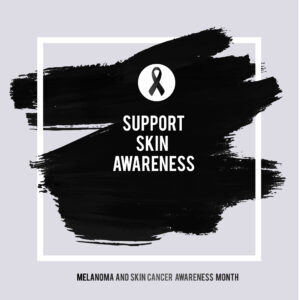April 23, 2018 | 3 minute read

Types of Skin Cancer
Non-melanoma
This occurs in the structures of the of the skin closer to the surface. The most common types are basal cell carcinoma (BCC) and squamous cell carcinoma (SCC). Over 3.5 million cases of BCC and SCC were diagnosed in 2015.
While all forms of skin cancer are dangerous if left untreated, non-melanoma skin cancers are more easily detected and removed.
Melanoma
A more aggressive and deadly form of skin cancer affects fewer people than non-melanoma, with 72,000 cases diagnosed in 2015. Melanoma occurs in the deeper layers of the skin and can be found even in areas that don’t receive high amounts of sun exposure. The risk of melanoma increases with age.
Risk of Skin Cancer
Here are a few facts regarding skin cancer:
- Chronic sun exposure increases your risk of developing skin cancer because of the UV rays produced by the sun.
- Over 400,000 cases of skin cancer are linked to indoor tanning each year.
- Your risk of skin cancer increases as you age. Even if you didn’t care for your skin properly when you were younger, you should start immediately to help prevent the development of skin cancer.
- While lighter skin pigments are more likely to develop skin cancer, the American population has the lowest survival rate, which may be affected by socio-economic factors, not biology.
Preventing Skin Cancer
Regardless of your age, you should begin taking steps to minimize your risk for skin cancer. Since most cases of skin cancer are caused by UV radiation, avoiding exposure to direct sunlight is the best prevention method, but since that is not always an option, here are some strategies you can use to protect yourself and others:
- Wear a broad-spectrum sunscreen when outdoors and reapply every few hours.
- Wear clothes that cover the majority of your skin.
- Stay in shaded areas.
- Keep newborns out of direct sunlight.
- Give yourself at-home exams to identify possible precancerous or cancerous lesions.
Removing Precancerous Lesions
If left untreated, precancerous lesions can develop into cancer, which is why self-checks at home are so important. Any lesion that has recently grown in size or exhibits irregular borders, color, or size should be looked at by a skin expert.
At O’Neil Skin & Lipo Center, we remove precancerous lesions and other surface abnormalities not only to restore the attractiveness of the skin, but to ensure the health of our patients.
Statistics and information provided by:
* https://www.skincancer.org/skin-cancer-information/skin-cancer-facts
